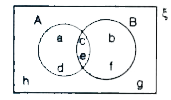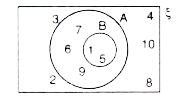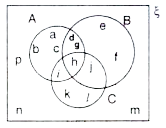Show that the following four conditions are equivalent :
(i) A⊂B
(ii) A−B=ϕ
(iii) A∪B=B
(iv) A∩B=A.
(i) Let A⊂B
⇒ All elements of A are in B
(ii) A−B=ϕ⇒ All elements of set A which are not in B∈ϕ
⇒ There is no element in set A which is not in B
⇒ All elements of set A are in set B
⇒A⊂B
∴A−B=ϕ⇒A⊂B
(iii) Let A∪B=B
∵A⊂A∪B
Therefore, A⊂B [∵ Given A∩B=B]
∴A∪B=B⇒A⊂B
(iv) Let A∩B=A
∵A∩B⊂B
⇒A⊂B [ ∵ Given A∩B=A]
∴A∩B=A⇒A⊂B
Therefore, four conditions are equivalent.
Topper's Solved these Questions
- SETSBOOK - NAGEEN PRAKASHAN ENGLISHCHAPTER - SETSEXERCISE - Exercise 1.6
8 Videos
- SEQUENCE AND SERIESBOOK - NAGEEN PRAKASHAN ENGLISHCHAPTER - SEQUENCE AND SERIESEXERCISE - Miscellaneous Exercise
32 Videos
- STATISTICSBOOK - NAGEEN PRAKASHAN ENGLISHCHAPTER - STATISTICSEXERCISE - MISCELLANEOUS EXERCISE
7 Videos
Similar Questions
Show that the following four conditions are equivalent:(i)A⊂B (ii) AB=φ (iii) A∪B=B (iv) A∩B=A
View SolutionFOR ANY TWO SETS AandB , show that the following statements are equivalent: A⊂B (ii) A−B=φ (iii) A∪B=B (iv) A∩B=A.
View SolutionIf A⊂B, then A∩B=?
View SolutionIf A⊂B, then A∪B=?
View SolutionFrom the given diagram find:
(i) A∪B
(ii) A'∩B
(iii) A-B
(iv) B-A
(v) (A∪B)'

View SolutionGiven, A = {Triangles}, B = {Isosceles triangles}, C = {Equilateral triangles}. State whether the following are true or false. Give reasons.
(i) A⊂B, (ii) B⊆A, (iii) C⊆B, (iv) B⊂A, (v) C⊂A, (vi) C⊆B⊆A
View SolutionUse the given Venn-diagram to find:
(i) B-A
(ii) A
(iii) B'
(iv) A∩B
(v) A∪B

View SolutionGiven, A = {Quadrilaterals}, B = {Rectangles}, C = {Squares}, D = {Rhombuses}. State, giving reasons, whether the following are true or false.
(i) B⊂C, (ii) D⊂B, (iii) C⊆B⊆A, (iv) D⊂A, (v) B⊇C, (iv) A⊇B⊇C
View SolutionUse the given diagram to find:
(i) A∪(B∩C)
(ii) B−(A−C)
(iii) A-B
(iv) A∩B'
is A∩B'=A−B?

View SolutionDraw a Venn-diagram to show the relationship between sets A and B , such that A⊆B. Now shade the region representing :
(i) A∪B, (ii) B'∩A, (iii) A∩B, (iv) (A∪B)'
View Solution
